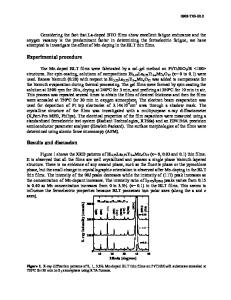Mechanisms of misfit strain relaxation in epitaxially grown BLT (Bi 4-x La x Ti 3 O 12 , x = 0.75) thin films
- PDF / 1,290,387 Bytes
- 6 Pages / 612 x 792 pts (letter) Page_size
- 46 Downloads / 309 Views
W5.23.1
Mechanisms of misfit strain relaxation in epitaxially grown BLT (Bi4-xLaxTi3O12, x = 0.75) thin films Hyung Seok Kim1, Sang Ho Oh1,2, Ju Hyung Suh1 and Chan Gyung Park1 1 Department of Material Science & Engineering Pohang University of Science and Technology (POSTECH), Pohang 790-784, Korea 2 Max-Planck-Institut für Metallforschung, Heisenbergstr. 3, 70569 Stuttgart, Germany ABSTRACT Mechanisms of misfit strain relaxation in epitaxially grown Bi4-xLaxTi3O12 (BLT) thin films deposited on SrTiO3 (STO) and LaAlO3 (LAO) substrates have been investigated by means of transmission electron microscopy (TEM). The misfit strain of 20 nm thick BLT films grown on STO substrate was relaxed by forming misfit dislocations at the interface. However, cracks were observed in 100 nm thick BLT films grown on the same STO. It was confirmed that cracks were formed because of high misfit strain accumulated with increasing the thickness of BLT, that was not sufficiently relaxed by misfit dislocations. In the case of the BLT film grown on LAO substrate, the magnitude of lattice misfit between BLT and LAO was very small (~1/10) in comparison with the case of the BLT grown on STO. The relatively small misfit strain formed in layered structure of the BLT films on LAO, therefore, was easily relaxed by distorting the film, rather than forming misfit dislocations or cracks, resulting in misorientation regions in the BLT film. INTRODUCTION Layered perovskite structured lantanium substituted bismuth titanate, Bi4-xLaxTi3O12 (BLT, x = 0.75) is a candidate material for ferroelectric random access memory (FRAM) capacitor due to its good fatigue property and large remnant polarization. The unit cell of BLT exhibits an anisotropic structure with lattice parameters of ao=0.54489 nm, bo=0.5410 nm, co=3.2815 nm [1]. Because of this highly anisotropic structure with long c axis, BLT thin films can easily be grown epitaxially with the [001] axis perpendicular to the film plane (generally called c-axis orientation) [2]. When the BLT thin film is epitaxially grown, the lattice mismatch between BLT film and substrate, usually, results in misfit strain at the interface. The misfit strain is usually relaxed by forming structural defects, such as misfit dislocations, cracks, twins, surface corrugation etc. These defects can cause significant degradation of electrical properties in FRAM devices [3].
Downloaded from https://www.cambridge.org/core. Access paid by the UCSB Libraries, on 04 Jul 2018 at 05:17:29, subject to the Cambridge Core terms of use, available at https://www.cambridge.org/core/terms. https://doi.org/10.1557/PROC-779-W5.23
W5.23.2
Therefore, careful investigation of misfit strain and defects in the epitaxial BLT thin film is quite helpful for the successful FRAM applications. So far, the mechanisms of misfit strain relaxation and defects in the BLT thin films are not, however, well understood. In the present work, mechanisms of misfit strain relaxation have been studied in the BLT thin films grown on SrTiO3 (STO) and LaAlO3 (LAO) subs
Data Loading...










